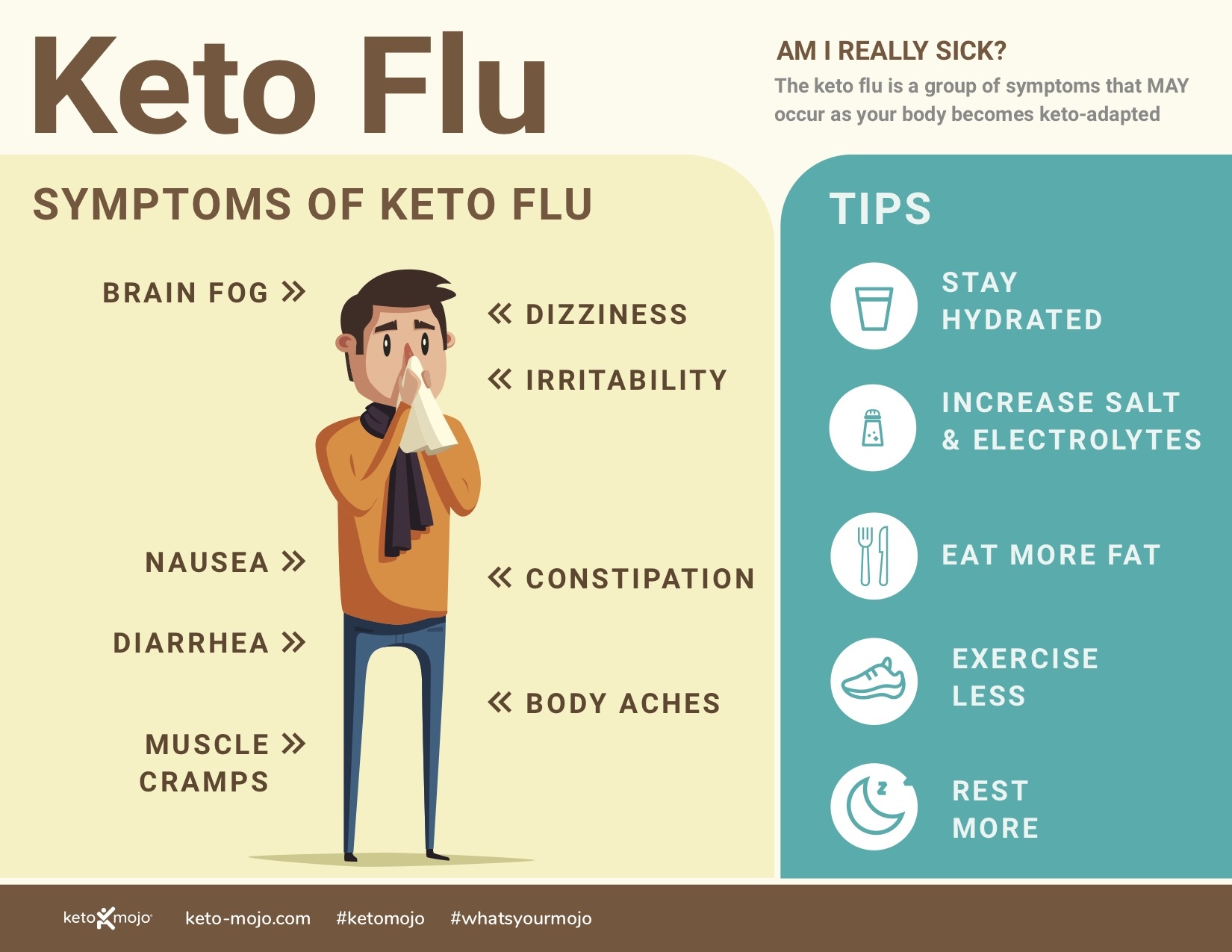“I feel miserable.”
Sound familiar? As you make your way through the first week or second week of a ketogenic diet, you may feel pretty lousy. But don’t despair! This is actually a good thing, because general malaise is an indication that what you’re doing is working and your body is making the bumpy transition from burning glucose (carbohydrates/sugar) for energy to burning fat through ketosis (ketones)! In fact, the unpleasant side effects associated with the keto transition are so common there’s a name for them: the “keto flu” or the “carb flu.”
What is keto flu, you wonder?
Keto flu is a blanket term for the variety of temporary side effects that may occur when you start a keto diet, eat only keto-friendly foods, and significantly lower your carbohydrate intake. Though short-term, it can feel similar to withdrawing from an addictive substance, which is essentially what you’re doing (Goodbye, sugar!). The good news is the flu-like symptoms are short-lived.
Even better, they can be mitigated as you go through this rite of passage, if you know what to do.
So, instead of suffering in low-carb-diet silence as you enter the keto diet for weight loss or other health benefits, read through the common symptoms and information here, check out this helpful video, and stick with it. The energizing, fat-burning rewards that come with the perseverance of the low-carbohydrate diet are coming! (Disclaimer: if you’re not feeling crappy, don’t worry–while the keto flu is common, not everyone suffers from it.)
Keto Flu Symptoms
It’s not just your mind that’s working hard to transition into a keto lifestyle. If you’ve been living on mostly carbs (glycogen)–and most people do–your body is figuring out what to do now that it can no longer depend on glucose as its energy source. Following are some common indicators that your body is sorting itself out and you’re experiencing the keto flu:
- Brain fog
- Body aches / muscle soreness
- Constipation
- Diarrhea
- Dizziness
- Drowsiness
- Muscle cramps/cramping
- Nausea
- Irritability
- Sugar cravings
Keto Flu Timing and Duration: How Long Does Keto Flu Last?
For the average person, keto flu symptoms may begin within the first day or two of dramatically restricting your carb intake, especially if you’ve been enjoying a diet high in refined sugar and processed foods (i.e. a high-carb diet). If your diet is already relatively low in processed sugars and starches when you start on the low-carb, high-fat diet you may encounter only mild keto-flu symptoms or no symptoms at all. As with everything in the keto lifestyle and life in general, everybody’s experience is different, and that’s okay. Even if you have a particularly intolerable case of the keto flu, the symptoms tend to last a week or less; it’s only on very rare occasions that they persist for longer, perhaps up to a month. If you’re suffering for any extended amount of time, it’s always a good idea to consult your healthcare provider.
Ways to Ward Off the Keto Flu
Following are a number of keto flu remedies you can use to lessen the physical unpleasantries as your body adjusts to its new fuel source:
- Drink plenty of water. The keto diet is diuretic, so dehydration is common and can cause all of the keto-flu symptoms listed above, especially because it aids in the loss of electrolytes (see below). Luckily, it’s also the easiest thing to remedy; make sure to drink enough water regularly throughout the day.
- Replenish electrolytes. The most common cause of keto flu is a deficit in electrolytes; if yours get low, you’ll feel tired. To solve the problem, maintain your electrolyte balance; add more sodium, magnesium, and potassium to your diet, perhaps through bone broth, avocados, or a sprinkling of Himalayan sea salt to your beverages or food.
- Eat more fat. (When was the last time you heard that?!) Another common cause of keto flu is not eating enough keto-friendly macros to maintain good energy levels. So, if you’re dragging, eat a healthy snack loaded with healthy fats, like celery with salted butter or some fresh, salted avocado. Some good leafy greens help, too, as they have lots of good macronutrients.
- Exercise a little less. Light activities such as walking, yoga and non-strenuous biking can help ward off flu symptoms, but you should avoid strenuous workouts with intense running or lifting weights as your body adapts. So, get out there and move your body a little, but don’t overdo it.
- Rest more. Get plenty of sleep nightly and rest when you feel tired. Shifting metabolic gears is hard work, so give your engine plenty of idle time!
Mojo On!
Feeling better yet? If not, relax and keep it up. Dietary changes always affect the body, and your body needs to settle into living in a state of ketosis. So grab yourself a tall glass of water, season it with a little sea salt, and toast to you for self care, hydration, and for pushing through in the name of better health. Even as you go through this time, your blood sugar and insulin levels will begin to normalize into a healthier state and your ketone levels will stay high enough to help your body transition quickly.
Also, remember: it’s always a good idea to seek medical advice before making dramatic changes to your diet.





